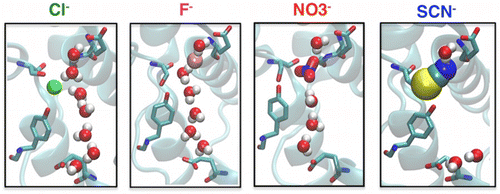Molecular Basis for Differential Anion Binding and Proton Coupling in the Cl–/H+ Exchanger ClC-ec1
By Tao Jiang, Wei Han, Merritt C. Maduke, and Emad Tajkhorshid.
Published in Journal of the American Chemical Society 2016 Mar 9;138(9):3066-75. PMID: 26880377. PMCID: 4898471. Link to publication page.
Projects: The Transport Cycle in Neurotransmitter Uptake Systems, Conformational Dynamics in the CLC Channel/Transporter Family . Core Facility: Computational Modeling.

Abstract
Cl–/H+ transporters of the CLC superfamily form a ubiquitous class of membrane proteins that catalyze stoichiometrically coupled exchange of Cl– and H+ across biological membranes. CLC transporters exchange H+ for halides and certain polyatomic anions, but exclude cations, F–, and larger physiological anions, such as PO43– and SO42–. Despite comparable transport rates of different anions, the H+ coupling in CLC transporters varies significantly depending on the chemical nature of the transported anion. Although the molecular mechanism of exchange remains unknown, studies on bacterial ClC-ec1 transporter revealed that Cl– binding to the central anion-binding site (Scen) is crucial for the anion-coupled H+ transport. Here, we show that Cl–, F–, NO3–, and SCN– display distinct binding coordinations at the Scen site and are hydrated in different manners. Consistent with the observation of differential bindings, ClC-ec1 exhibits markedly variable ability to support the formation of the transient water wires, which are necessary to support the connection of the two H+ transfer sites (Gluin and Gluex), in the presence of different anions. While continuous water wires are frequently observed in the presence of physiologically transported Cl–, binding of F– or NO3– leads to the formation of pseudo-water-wires that are substantially different from the wires formed with Cl–. Binding of SCN–, however, eliminates the water wires altogether. These findings provide structural details of anion binding in ClC-ec1 and reveal a putative atomic-level mechanism for the decoupling of H+ transport to the transport of anions other than Cl–.


